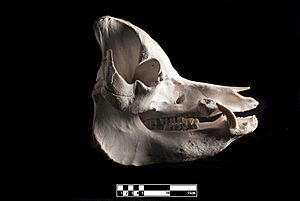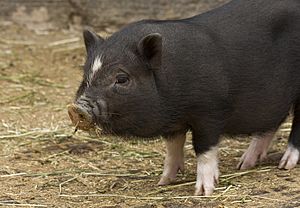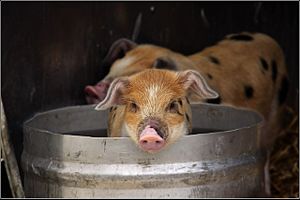Pig facts for kids
Quick facts for kids Pig |
|
|---|---|
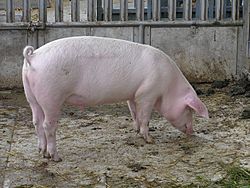 |
|
| A domestic pig on an organic farm in Switzerland |
|
| Conservation status | |
| Scientific classification | |
| Kingdom: | |
| Phylum: | |
| Class: | |
| Order: | |
| Family: | |
| Genus: |
Sus
|
| Species: | |
Pigs are mammals that belong to the group called Sus. This group includes the domestic pig and its wild ancestor, the wild boar. Other types of pigs are also part of this group. Pigs are part of the Suidae family. They are known as even-toed ungulates, meaning they walk on an even number of toes.
Other animals related to pigs, but not in the Sus group, are the babirusa and the warthog. Pigs, and all animals in the Suidae family, originally came from the Old World (Europe, Asia, and Africa). Baby pigs are called piglets. Pigs eat both plants and animals, which means they are omnivores. They are also very social and smart animals.
Domestic pigs are often raised for food, like pork or bacon. Some religions, like Jewish and Muslim faiths, and some Christian groups, do not eat pork. However, pork can be a healthy food for humans. Pig farmers make sure their animals are healthy. They prevent diseases or parasites that could harm people.
Most domestic pigs are pink. But smaller pigs kept as pets, like pot-bellied pigs, can be many other colors. Pigs often roll in mud to protect their skin from the sun. Many people think pigs are dirty or smelly. Actually, rolling in mud helps them in many ways. It keeps bugs and ticks off their skin. It also helps keep their skin moist and cools them down on hot days.
Pigs are very intelligent animals. They can learn many tricks. They can be taught to dance, find truffles, race, and pull carts. Some pigs can even sniff out landmines. They have even learned to play video games!
Contents
What Do Pigs Look Like?
A typical pig has a big head and a long snout. The snout is strong because it has a special bone and a tough tip. Pigs use their snout to dig in the soil to find food. Their snout is also a very good sense organ for smelling.
Pigs have four hoofed toes on each foot. The two bigger toes in the middle carry most of the pig's weight. The two outer toes help them walk on soft ground.
Adult pigs have a lot of teeth, usually 44 in total. Their back teeth are good for crushing food. Male pigs have tusks, which are long canine teeth. These tusks grow all the time and stay sharp by rubbing against each other.
Where Do Pigs Live?
There are about 1 billion domestic pigs alive at any time. This makes them one of the most common large mammals on Earth.
The wild ancestor of the domestic pig is the wild boar. Wild boars are also very common and live in many places. They are found in most parts of Eurasia and its islands, and also in Africa. They live in many different climates, from Ireland to Japan and even Siberia.
Pigs on islands like Indonesia, Malaysia, and the Philippines have changed over time. They have become different species, like bearded pigs and warty pigs. Humans have also brought pigs to Australia, North and South America, and many islands. Sometimes these were escaped domestic pigs that became feral (wild again). Other times, wild boars were brought there on purpose.
Pig Habitats and Reproduction
Wild pigs (Sus scrofa) can find food in many different places. This means they can live in almost any habitat that has enough water for large animals like them. If too many wild pigs live in one area, they might not find enough food. This can cause the pig population to go down. But if there is enough food again, the pig population will likely grow quickly. This is because pigs naturally have a high reproduction rate.
What Do Pigs Eat?
Pigs are omnivores, which means they eat both plants and animals. In the wild, they look for food by digging. They mostly eat leaves, roots, fruits, and flowers. They also eat some insects and fish.
When pigs are raised on farms, they are usually fed corn and soybean meal. This food also has vitamins and minerals added to it. Long ago, pigs were often raised on dairy farms. They were called "mortgage lifters" because they could eat extra milk and leftover whey from making cheese and butter. Older pigs drink a lot of water, about three to five gallons every day.
If you keep a pig as a pet, it should mostly eat a balanced diet of raw vegetables. Some pet pigs also eat special "mini pig" pellet food.
Pigs and People
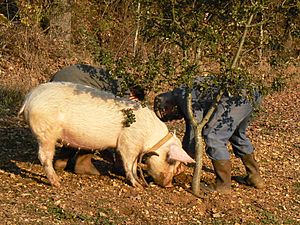
Domesticated pigs, especially miniature breeds, are often kept as pets. Domestic pigs are also raised on farms for many reasons. People use their meat, called pork. They also use their leather and their stiff hairs, called bristles, to make brushes.
Because pigs are so good at finding food and have an amazing sense of smell, they are used to find truffles in many European countries. Both wild pigs and feral pigs are often hunted by people.
Pig bristles were once very important for making paintbrushes. In 1946, the Australian Government even started something called "Operation Pig Bristle." After World War II, there was a big need for paintbrushes to paint houses. In May 1946, the Royal Australian Air Force (RAAF) flew 28 short tons of pig bristles from China. At that time, China was the only place to get enough bristles.
Caring for Pigs
Pigs need a warm, clean place to sleep that has a roof. They should not be too crowded. Farmers need to check them regularly to make sure they are not sick. If pigs are stressed, they can get sick more easily.
Pigs need a lot of water because more than half of their body is made of water. Adult pigs should be given all the food they want to eat, usually about 4 to 5 pounds a day. Corn is good for pigs, but they also need extra protein.
Where You Can Find Pigs
Pigs are often found on farms all over the world. They can also be popular pets. A new type of very small pig, called a micro pig, has become popular. But sometimes, baby pigs are sold as micro pigs and then grow much bigger than expected.
In some places, pigs are raised in large numbers to produce meat. These farms can sometimes be very crowded. You can find pigs both on farms and living wild in nature.
Images for kids
-
Bronze pig sculpture, Zhou dynasty
-
A Large White, a breed commonly used in meat production
See also
 In Spanish: Cerdo doméstico para niños
In Spanish: Cerdo doméstico para niños


